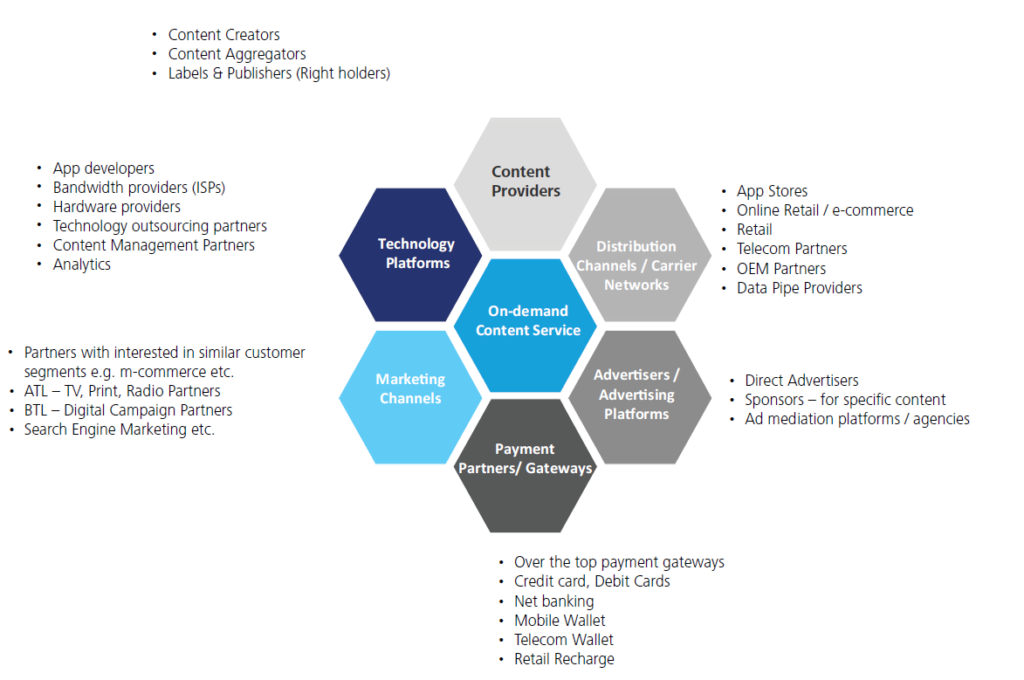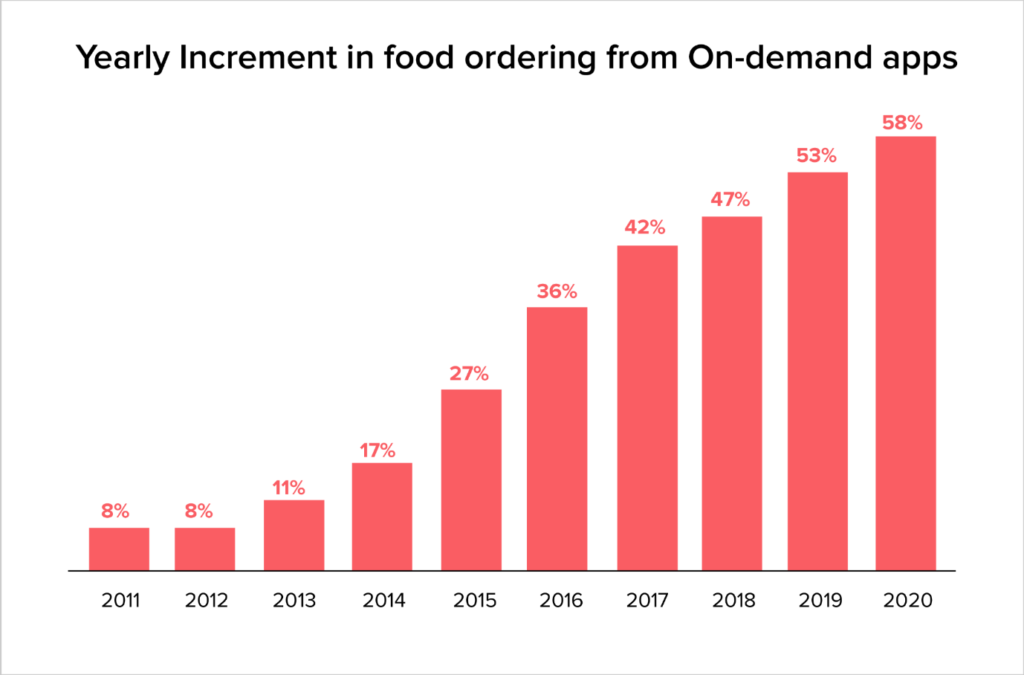
The On-Demand economy has supplanted traditional business models faster than we anticipated. The administrations combined with two or three applications empower the provisioning of products and enterprises.
The On-Demand Economy is defined as the economic activity created by technology companies that fulfill consumer demand via the immediate provisioning of goods and services.
Supply is driven via an efficient, intuitive digital mesh layered on top of existing infrastructure networks.
The On-Demand Economy is revolutionizing commercial behavior in cities around the world.
The number of enterprises, the categories represented, and the industry’s growth are all increasing at a rapid rate. Businesses in this new economy are the result of years of technological advancements and changes in customer behavior.
Many ask: Is this a bubble? Is this a short-term trend? Is the hyper-growth we’re seeing going to slow soon? Categorically and unequivocally — the answer is no. The new on-demand models have opened the door to real-time fulfillment of goods and services, which consumers have embraced with a frequency that is unprecedented.
It is no longer a question of if the On-Demand Economy will revolutionize the way people transact or create thousands of jobs or move governments … this is all happening.
The economy has made its reach in every online business sector transacting today in 2021.

The On-Demand Economy has shown an usher in a paradigm shift similar to what was seen with the advent of the internet in the late 1990s.
Why is the on-demand economy expanding at such a rapid pace?
“The internet makes human desires more easily attainable. In other words, it offers convenience. Convenience on the internet is basically achieved by two things: speed, and cognitive ease. If you study what the really big things on the internet are, you realize they are masters at making things fast and not making people think.”
— Ev Williams, Twitter co-founder
In the analogy, consumer behavior has turned. Smartphones provide instant access to texting, e-mail, media, and other online activities, instilling a sense of entitlement to quick, easy, and efficient interactions. According to The On-Demand Economy’s survey of 250 Whole Foods and Trader Joe’s customers, “ease of delivery” was the most important factor in consumers’ decision to buy food online.
The report reveals that the on-demand economy’s growth is a result of its alignment with consumers’ growing need for greater convenience, speed, and simplicity, whether it’s the ease of scheduled deliveries or the commensurate reduction in time required.
Fast-moving technology businesses competing in this space have created new models that are altering industries that have traditionally lagged behind in terms of innovation. In the on-demand world, the ground transportation, grocery, and restaurant industries are great examples of hyper-growth categories, with growth owing in large part to the deployment of new technologies on top of existing infrastructure.

“Welcome to the uberification of our service economy,” says RRE’s Steve Schlafman. Market circumstances and technology advancements driving the growth in on-demand services include a huge increase in the number of smartphone-connected users, simple and secure transaction flows, and location-based services, to name a few.
How is the business world being disrupted by the on-demand economy?
- Increased prospects
One of the biggest challenges that the on-demand business model has solved is the friction in the offline purchasing process. This business model has made it possible for customers to order any goods or services online and have them delivered to their homes in real-time. Consumers have praised the efficiency and ease with which the services are delivered, leading them to prefer organizations that provide on-demand services.
As a result, practically everyone is looking forward to riding the uprising ‘Uber for X‘ wave today. They’re building on-demand firms in a variety of industries, including healthcare, transportation, education, and retail.
- Entrepreneurship is emphasized.
On-demand software solutions are also helping to bridge the gap between entrepreneurship and the corporate world. It allows employees to choose their own working hours and receive remuneration based on the amount of work completed. This has made life easier for those who want to start their own business or who need to work numerous jobs to make ends meet. It has also had a huge impact on company culture, causing everyone to admire each other’s entrepreneurial spirit.
- Increased customization
Consumers have had a taste of tailored services thanks to Uber, Airbnb, Via, Instacart, and other on-demand delivery services startups’ functionality of gathering and analyzing user data. They are dissatisfied with traditional business processes and want every organization to function in such a way that they may have a highly engaging experience.
This has presented a great opportunity for enterprises in specialized industries that have yet to be challenged by the on-demand economy. Furthermore, consider how to provide the best-customized services in order to be the first in their specialized market.
- More flexibility in the workplace
As previously said, the on-demand business model allows employees to choose their own working hours and be compensated accordingly. This has increased workplace flexibility, allowing everyone to contribute to their full potential while studying, taking holidays, and conducting other daily tasks. And, in the end, provide greater employee happiness and corporate expansion.
- Expanded scalability
On-demand app services are extremely safe and scalable. As a result, when you integrate them into your business processes, you obtain a highly scalable way for meeting your company’s various needs.
These suggestions have convinced entrepreneurs and marketers that the on-demand business model is more profitable than the traditional approach and that switching to the former is a must.
How can the on-demand economy impact your business?
If you’re still unsure whether this is the best move for your company, scroll down right now.
As per the Harvard Business Review, more than 22.4 Mn users spend over $57.6 Bn on On-demand services. This includes spending of around $36 Bn on On-demand marketplaces, $5.6 Bn on taxi services, and $4.6 Bn on food/grocery delivery services, annually.
Also, it has been noted that 86.5 Mn US citizens have used an on-demand service at least once in their lives.
Another report states that 51% of people who offered online services in the on-demand economy saw a rise in their financial situation, while 64% of them are hoping for an improvement in the future.
Average on-demand spending per year is shown below in graph

Such on-demand mobile app economy statistics are clearly indicating the proliferating market scope and encouraging everyone to step into his economy and leverage a wider range of advantages. But, what’s more interesting is the way it is transforming the traditional business model.
Major industries propelling the on-demand economy
Since Uber disrupted the industry by creating one of the first on-demand apps, it has influenced other industries to implement similar concepts.
Some of the popular apps that are driving the on-demand economy are Postmates (on-demand food delivery app), Drizly (on-demand alcohol delivery app), Handy (on-demand moving app), Lyft (on-demand cab booking app), InstaCart (on-demand grocery delivery app), and many more.
According to a survey conducted by Burson-Marsteller, the Aspen Institute, and Time, over half of all Americans (42%) had used at least one on-demand service.
Not only that, but one of the main reasons why on-demand apps are driving the economy is that they employ 22 percent of the population or 45.3 million people.
This is the compelling rationale for VCs and Angel investors to back any firm that uses the term “on-demand” in its business strategy.
The emergence of on-demand services has prompted businesses and startups all over the world to automate their services and make them more accessible to customers.
- Travel
After the online marketplace, travel is the industry that is most affected by the on-demand economy, thanks to Uber.
Apart from that, the top five on-demand firms in the globe, four of which are in the travel and transportation industry, have garnered more than 75% of total funding.
When we consider the scale of success that Airbnb and Uber have achieved, they should be viewed as inspiration rather than competition for new entrepreneurs.
The data for US on-demand transportation market size, by service type, 2018-2025 is shown below in the graph.

The example of Didi, a cab booking app in China, tells us that nothing is impossible. It beat Uber in its own game and became the #1 cab booking app in China.
This is not the first time that Uber faced a setback. In India, Ola is giving tough competition to Uber by providing similar yet one of a kind taxi on-demand taxi booking services.
Some successful business models-
How Uber Works: Insights into the Business & Revenue Model
How Lyft Works: Insights into Business Model
How to Build a Corporate CarPool App?
- Food Delivery
Food delivery apps have metamorphosed the way we access and consume food. They’ve reimagined the concept of food accessibility – they save time, are quick, and only take a few phone clicks.
In recent years, many food entrepreneurs have developed quickly and globally. Food solutions are always in demand, so it’s a perfect place to start building your on-demand food software.
On-demand food delivery applications are now widely used for breakfast, lunch, supper, and even snacks. According to Statista, the online food delivery sector in the United States generated US$306,808 million in sales in 2021 and is expected to show an annual growth rate (CAGR 2021-2025) of 10.01%, resulting in a projected market volume of US$449,292m by 2025.
For eateries that did not previously provide home delivery, on-demand food delivery applications have proven to be a godsend. Both restaurants and customers are charged by these food delivery companies.
Yearly increment in food ordering from on-demand apps till 2020 is projected in the below graph.

In countries like the United States, the United Kingdom, and India, the market has already matured. In countries like Saudi Arabia, South Korea, and Brazil, on the other hand, it is still expanding.
Some successful food delivery business models
InstaCart Business Model: How it Works?
How GrubHub Works: Business Model Explained.
Food On Demand: Business Models of Meal Delivery Startups
What does it cost to make an app like UberEats?
- Healthcare
One market, in particular, that is in severe need of on-demand services is healthcare. Patients are currently standing in line for hours waiting for their turn.
Furthermore, in one city, there are just a few pharmacies that are open 24 hours a day, seven days a week. As a result, patients confront numerous difficulties in the event of an emergency.
The healthcare business has been transformed by on-demand services. Patients can now order drugs from the comfort of their own homes at any time.
The app not only allows you to order medicines and have them delivered to your door, but it also allows you to schedule doctor appointments and receive medical reports.
Possibilities for On-Demand Health Care Services include the following:
Call a doctor at home (e.g., Doctor on Demand)
Talk to any doctor across the country or world (e.g., Healthtap)
Order medicine 24/7 (e.g., Pillpack)
Successful business model-
- Home Services
With the emergence of the on-demand economy, the home services sector witnessed a significant shift. It was also one of the most conservative industries to adopt the on-demand economy.
Following healthcare, this is another industry that desperately needed to join the on-demand economy. Home services have the most potential because they encompass all professional services such as machine repair, carpentry, pest control, electrician, babysitting, plumbing, and housekeeping work.
No app can deliver all of the functions in one place. Customers can choose from a variety of apps that provide various services. For example…
NuevaCare (On-demand home care services provider for elders)
Handy and Serviz (On-demand field services to contact electrician, plumber, and more)
Some successful business models-
How Does the Urbanclap/ Urban Company Business Model Generate Revenue?
- Transportation & Logistics
Transportation and logistics are delicate industries. However, it, like other verticals, suffered a significant transformation after entering the on-demand economy.
Logistics services have been more efficient and smooth than ever before because to on-demand moving apps like Postmates, Deliv, GetWagon, and others.
Small players/independent movers and packers have been able to reach out to more customers, thanks to on-demand apps. Customer experience has also improved thanks to mobile apps.
Previously, courier monitoring via SMS was available from transportation providers. Customers may now track the courier in real-time using integrated maps, thanks to an upgrade to a smartphone app.
Apart from these benefits, on-demand apps also regulated the messy price structure of the various transportation companies and individual transporters.
Some successful business models-
How DoorDash Works | Business Model & Revenue Sources Explained
How FedEx Works – Business Model & Revenue Sources
How you can take advantage of this boom?
It’s clear that on-demand solutions will remain dominant in years to come as the chase for convenience and accessibility doesn’t seem to die down. As technology climbs up the ladder, consumer demands and trends will skyrocket.

On-demand business model targets delivering solutions to customers at the moment, which has always been an innate consumer need. Getting everything at your doorstep at any hour of the day feels like magic and gives consumers a sense of empowerment.
The future of on-demand solutions is bright, as newer technological enhancements are turning user experience a notch up. With seamless UIs, and use of AI has now altered the way we shop and transact. On-demand business services have taken a further leap as we have become more dependent on solutions that give us instant gratification.
Regardless of what type of business you run or what products and services you sell, your customers are the most important aspect of your company.
As a result, it’s critical to comprehend your target audience, who they are, and what they truly desire. You will lose if you do not adjust your business plan to reflect your clients’ evolving requirements and demands.
Uber, Amazon, and Netflix are just a few examples of companies that have digitally transformed themselves in response to changing customer demands and portability, resulting in significant revenue.
But On-Demand economy is not limited to only these. Corporates are coming with new ideas and applying the on-demand model in every business.
Like –
Real-estate On-Demand Economy Service Business
On-Demand Economy Print Services
On-Demand Economy Business Intelligence
And many more….
But don’t worry we have covered this all for you
From food ordering and delivery platforms to pharmacies, grocery, beauty, alcohol, cannabis, and any use-case you can think of, Jungleworks provide a platform to set up your on-demand business from anywhere at any time.
We offer end-to-end customizable ready-made platforms, endearing to enterprises or businesses which need to go online, prototype software, and automate processes quickly.
Be it a hyperlocal business, direct-to-consumer or headless, Jungleworks no-code platform is suitable for your every business need.
Jungleworks offers inbuilt themes and other pre-created aesthetic elements to help you craft your own brand image. All these creative aspects are provided to make your business feel highly personalized to the users, thus enhancing their shopping experience. Moreover, Jungleworks gives you access to several other advanced features such as 100+ payment gateways, high-tech integrations, availability in 50+ languages, setting access control, and much more.
Setting up an on-demand business has never been easier. Try now, Start from 14 days free trial!
Subscribe to stay ahead with the latest updates and entrepreneurial insights!

Subscribe to our newsletter
Get access to the latest industry & product insights.




























